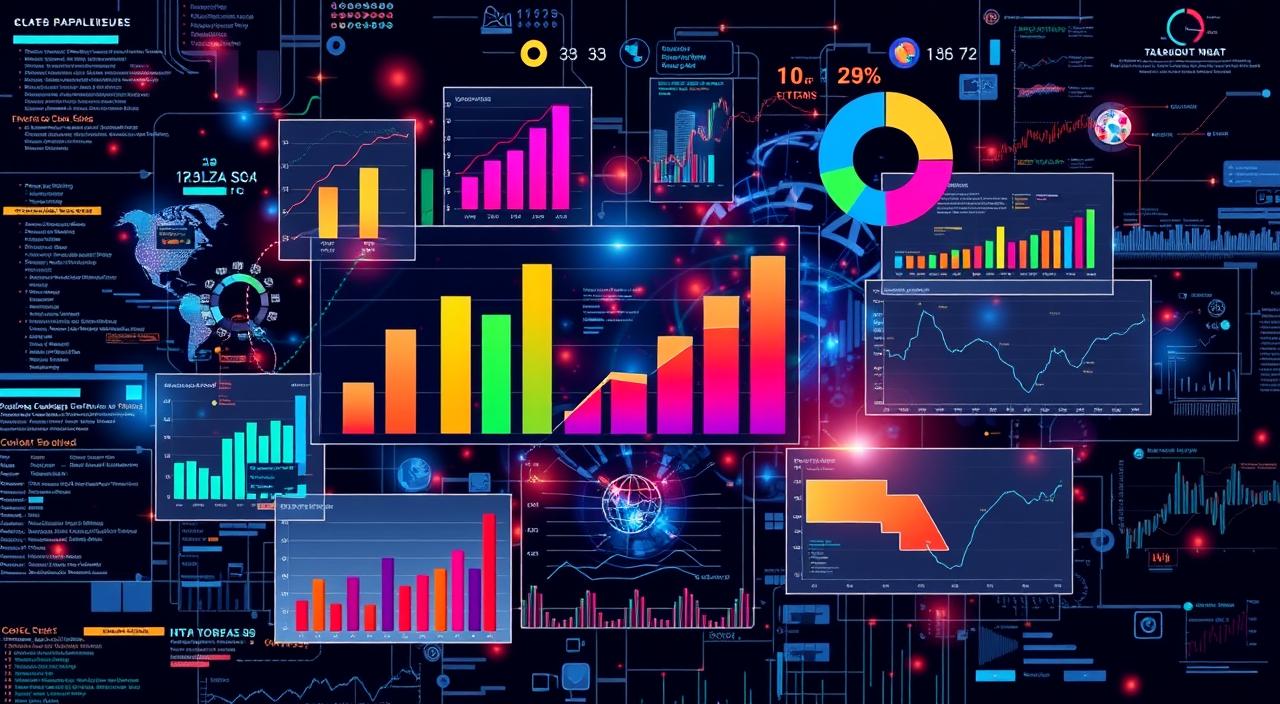In today’s world, knowing how to analyze data is key. It helps us make smart choices, find hidden trends, and get deep insights. As more jobs need people who can analyze data, learning these skills is critical. This article will show you 10 easy ways to improve your business intelligence exercises, power bi exercises, and other data analysis techniques.
Whether you’re just starting or want to get better, these methods will give you the tools to understand data. You’ll learn how to find valuable information from it.
Key Takeaways
- Mastering the basics of data analysis and data visualization is key for making good decisions.
- Getting an education in data analytics, like degrees or online courses, can sharpen your skills.
- Knowing how to manipulate data and use exploratory data analysis can uncover new insights.
- Learning about machine learning and improving your statistical knowledge makes your analysis smarter.
- Using modern data analysis tools, like Tableau or Power BI, can make you more efficient.
Mastering Fundamentals of Data Analysis
To excel in data analysis, you need a solid foundation. Start by learning statistics for data analysis. This skill helps you understand data patterns and make accurate conclusions. Next, learn data visualization techniques to present insights clearly and effectively.
Programming languages like Python and R are key for data analysis. They let you work with data precisely. Luckily, many data analysis online tutorials are out there to help you learn at your own pace.
Understanding Statistics and Data Visualization
Statistics are vital in data analysis fundamentals. They help you interpret data and find important insights. Learn about population, normal distribution, and variance. These skills help you make accurate conclusions from your data.
Also, explore data visualization techniques. Learn to use charts and graphs to present data. Mastering tools like scatter plots and bar charts will help you share your findings clearly.
Learning Programming Languages for Data Manipulation
To fully use data analysis, learn programming languages like Python and R. These tools help you automate tasks, do complex analyses, and create interactive visualizations. Check out online tutorials to improve your skills in these data analysis programming languages.
By focusing on statistics for data analysis, data visualization techniques, and data analysis programming languages, you’ll set yourself up for success. Keep learning and growing, and you’ll unlock the full power of data-driven insights.
Pursuing Educational Programs in Data Analytics
Starting your journey in data analytics education is a smart step. It boosts your skills and opens doors to new career paths. You can choose from degrees, bootcamps, or online courses, fitting your learning style and goals.
Degrees and Bootcamps in Data Analytics
A master’s degree in data analytics usually takes two years. It gives you a solid foundation in statistical analysis, data mining, and machine learning. This prepares you well for a career in data analytics.
Bootcamps, on the other hand, offer quick, hands-on training. They focus on practical skills and real-world applications. These programs are great for those who want to learn fast and get a job quickly.
Online Courses for Self-Paced Learning
Online courses offer flexibility and self-directed learning. They cover a wide range of topics, from basics to advanced skills. With these courses, you can learn at your own pace and on your own schedule.
This flexibility lets you focus on your own data analytics degree programs or data analytics bootcamps. It’s a great way to enhance your skills and knowledge in data analytics.
| Program | Duration | Cost | Time Commitment | Minimum Score | Post-Program Support |
|---|---|---|---|---|---|
| Emory Continuing Education’s Business Intelligence for Data Science and Visualization Certificate | 11 weeks | $4,995 | 100 hours | 75% | Resume writing and LinkedIn profile enhancement |
| Year Up United’s Data Analytics Training | Not specified | Not specified | Not specified | Not specified | Preparation for data analytics roles |
“Investing in your data analytics education is a strategic move that can unlock new career possibilities and propel you towards success in the data-driven business landscape.”
Data Manipulation Techniques for Effective Analysis
Data manipulation is key in data analysis. It helps clean and filter data, making it ready for deep analysis. This way, you can find valuable insights that guide smart decisions.
SQL is a powerful tool for this. It lets you query databases and work with data in complex ways. Knowing SQL is essential for handling big data sets.
Spreadsheet software like Microsoft Excel also helps a lot. It has many formulas and functions for data work. With Excel, you can clean, format, and analyze data easily.
To get better at data manipulation, check out YouTube tutorials and data analysis community forums. These places have great resources for learning. They also let you meet other data lovers and experts.
“Data manipulation is the lifeblood of effective data analysis. By mastering these techniques, you can transform raw data into actionable insights that drive better business decisions.” – Jane Doe, Data Analyst
Understanding your data is the first step. Then, figure out what changes it needs. Use the right tools and methods to reach your analysis goals. With these skills, you can make the most of your data and find important insights.
Exploratory Data Analysis: Unveiling Hidden Insights
Exploratory data analysis (EDA) is key in understanding your data. It helps you find valuable insights in your datasets. By using data summarization techniques and data visualization methods, you can understand your data better. This helps you spot patterns, relationships, and oddities that guide your next steps.
Summarizing Data and Visualizing Patterns
Start by looking at descriptive statistics like the mean, median, and standard deviation. These give you a basic idea of your data’s shape and center. Then, use visual tools like histograms, scatter plots, and box plots to see trends, outliers, and connections between variables.
Python’s pandas and numpy libraries make EDA easier. They help you clean and transform your data. This gets your data ready for deeper analysis.
Leveraging Python Libraries for EDA
For making plots, Python has many libraries like Matplotlib and Seaborn. These let you create plots that are both pretty and informative. Keeping a record of your exploratory data analysis is important. It helps you see how far you’ve come and what to explore next.
By diving into exploratory data analysis, you can find hidden treasures in your data. This is the start of making better decisions and creating real business value. Learning these data summarization techniques and data visualization methods will boost your python for data analysis skills. It will lead you to success in using data to drive your work.
Embracing Machine Learning for Intelligent Analysis
Machine learning is changing how we analyze data. It trains algorithms to learn from data, revealing patterns we can’t see. Techniques like linear regression and decision trees help us understand trends and classify data.
Adding machine learning to business intelligence systems improves decision-making. These algorithms can process huge amounts of data quickly. This helps businesses predict trends and tailor products to customers.
Machine learning also automates finding insights in data. This saves time for analysts to focus on strategy. It spots fraud and improves security, making operations more efficient.
Using machine learning is now essential for staying competitive. Over 90% of businesses see AI as key to staying ahead. Integrating it into BI tools is vital for making smart decisions and driving innovation.
| Machine Learning Benefits for BI | Statistics |
|---|---|
| Predictive analytics and forecasting | Companies implementing predictive analytics can enhance their decision-making processes by up to 80%. |
| Customer behavior analysis and personalization | Businesses leverage ML algorithms to analyze customer behavior and preferences for providing personalized product recommendations. |
| Anomaly detection and fraud prevention | ML algorithms can enhance BI systems by detecting unusual patterns or anomalies in data for fraud detection and security. |
| Automated data processing and insights generation | Over 70% of data professionals spend their time on data preparation, which can be automated by ML. |
| Continuous learning and adaptation | Machine Learning models continuously learn from new data, adapting to changes in business environments for continuous learning and adaptation. |
By embracing machine learning, businesses can unlock their data’s full value. This leads to better, more strategic decisions. As AI in BI grows, those who integrate machine learning will have a big edge.
“Machine learning is the future of business intelligence. By harnessing the power of predictive analytics and intelligent algorithms, organizations can make more informed decisions, anticipate market trends, and stay ahead of the competition.”
Enhancing Statistical Knowledge for Accurate Conclusions
Learning statistical concepts is key for becoming a top-notch data analyst. Knowing about probability distributions, hypothesis testing, and regression analysis lets you make solid conclusions from data. These tools help you understand uncertainty, check assumptions, and see how variables relate to each other.
Probability Distributions and Hypothesis Testing
Probability distributions, like the normal or Poisson, help you figure out the chances of different outcomes. Hypothesis testing lets you check if your assumptions are right. Together, these methods help you make smart choices based on the data.
Regression Analysis for Variable Relationships
Regression analysis is a strong tool for studying how variables interact. It includes methods like linear or logistic regression. By using these, you can find out how different factors affect your data. This way, you can understand your findings better and make informed decisions.
To get better at statistics, check out online tutorials or courses. Books like “Statistics for Beginners” by Sarah Allen can also help. Improving your statistical skills lets you do more advanced data analysis and make better decisions.
| Statistical Concept | Application | Benefit |
|---|---|---|
| Probability Distributions | Modeling uncertainty and likelihood of outcomes | Quantify the probability of different scenarios, enabling more informed decision-making |
| Hypothesis Testing | Validating assumptions and drawing conclusions | Statistically evaluate the validity of hypotheses, ensuring the reliability of findings |
| Regression Analysis | Exploring relationships between variables | Uncover insights about how factors influence data, supporting more accurate predictions and decision-making |
By diving into these statistical ideas and methods, you’ll boost your data analysis skills. You’ll feel more confident in drawing accurate conclusions from your work.
Leveraging Modern Data Analysis Tools
In today’s world, businesses rely on powerful data tools to make smart decisions. Tableau, Power BI, and Jupyter Notebooks are top choices. They help users find valuable insights.
Tableau and Power BI make it easy for anyone to dive into data. They turn complex data into clear, visual reports. This helps businesses spot trends and opportunities they might miss.
Jupyter Notebooks offer a hands-on way to work with data. It’s great for data scientists and analysts. They can easily share and work on projects together.
There are many online resources and forums for these tools. Sites like Tableau Public and Power BI Community have tutorials and support. They help users improve their skills and find new ways to use these tools.
Using modern data tools and online resources can help businesses make better decisions. They can uncover important insights and stay ahead in the data world.
Acquiring Domain Expertise for Contextual Analysis
In data analysis, knowing your domain is key. It helps you understand the field you’re working in, like healthcare, finance, or marketing. This knowledge lets you see the data’s true meaning and find important insights.
It’s important to learn about your field. For example, healthcare data needs you to know medical terms and patient info. Finance data analysis means you must grasp financial markets and economic signs.
- AutoZone Business Account: Fleet Services & Savings
- Dash Cam for Small Businesses: Protect Your Fleet
Look for data specific to your field, like stock data or customer habits. Use methods that fit your area. This way, you can find insights others might miss, making your analysis more valuable.
Get to know experts, go to workshops, and read a lot about your field. This will help you make better choices and ask the right questions. You’ll understand data better, leading to more effective data analysis in your industry.
| Domain Expertise | Key Considerations |
|---|---|
| Healthcare Data Analysis | Medical terminology, patient demographics, healthcare system dynamics |
| Finance Data Analysis | Financial markets, economic indicators, industry-specific metrics |
| Marketing Data Analysis | Consumer behavior, advertising and promotion strategies, market trends |
“Data without domain expertise is like a ship without a rudder – it may float, but it won’t go anywhere meaningful.”
Undertaking Practical Data Analysis Projects
Getting good at data analysis means doing real projects. These projects help you use what you’ve learned and understand how data works in real life. They let you improve your data analysis project planning, data analysis project communication, and data analysis project management skills.
Defining Objectives and Planning Approach
Start any data analysis project by setting clear goals. Know what problem you’re trying to solve and what questions you need to answer. Make sure you have all the data you need from different sources.
Plan your project well, breaking it down into smaller steps. Keep track of your progress and document it.
Communicating Findings and Insights
Turning data into useful insights needs good communication. Use strong data visualization to show your findings clearly. Make reports and presentations that are easy to understand.
Make sure your message fits your audience, whether it’s stakeholders, colleagues, or clients.
| Key Statistics | Insights |
|---|---|
|
|
Doing practical data analysis projects and using real-world data analysis case studies helps you learn a lot. You’ll get better at data analysis project planning, data analysis project communication, and data analysis project management. This is essential for being great at data analysis.
Continuous Learning and Professional Development
In the fast-paced world of data analysis, staying ahead means always learning. The field changes quickly, so it’s key to keep learning new skills. By taking part in various learning activities, you can grow your skills, stay current with trends, and find new ways to advance.
Attending Workshops, Webinars, and Conferences
Workshops, webinars, and conferences are great for learning. They let you hear from experts, learn about new methods, and meet others in your field. Look for local and online events that are affordable or free. Being part of these events can boost your knowledge, spark new ideas, and lead to teamwork.
Joining Data Analysis Communities
Being part of data analysis groups is also beneficial. Online forums, social media groups, and professional networks help you connect and share. Sites like Reddit’s r/DataAnalysis, Stack Overflow, and LinkedIn groups for data analysis are full of resources and support. By joining these groups, you can keep up with trends, get advice, and make connections that can help your career.
Learning never stops in data analysis. By exploring different learning paths and using online tools, you can improve your skills, stay current, and reach your career goals.
“Continuous learning is the key to unlocking new possibilities in the world of data analysis. Stay curious, embrace change, and never stop growing.”
business intelligence exercises
In today’s world, using business intelligence (BI) is key to staying ahead. BI exercises improve data analysis skills and help make better decisions. They cover everything from basic data analysis to advanced tools like Power BI and Tableau.
BI exercises focus on data manipulation and visualization. You’ll learn about statistical analysis, programming, and making dashboards. These skills help find hidden insights and share complex data clearly.
These exercises use real-world scenarios. This way, you can apply what you learn to solve real problems. It makes you ready for the modern data-driven job market.
BI exercises are great for anyone looking to grow in their career. There are many online courses and platforms to learn from. You can really improve your BI skills.
“Effective business intelligence empowers organizations to make data-driven decisions, optimize operations, and stay ahead of the competition.”
By doing BI exercises, you get better at technical skills and also improve your thinking and communication. These are key for success in data analytics.
Investing in BI exercises is smart for both you and your company. It prepares you to handle the changing BI world. You’ll be ready to help your organization grow with data.
Conclusion
As you’ve looked into ways to boost your data analysis skills, we need to wrap up with some key points. Investing in these skills opens up many opportunities. You’ll be able to make smart decisions, find hidden patterns, and get valuable insights from data.
Whether you’re just starting or have lots of experience, getting better at data analysis will help you succeed. It’s all about making informed choices and understanding data better.
Keep learning, use new tools and methods, and apply what you know to real projects. With hard work and determination, you can improve your data analysis skills. This will make you a valuable asset in any field.
Developing data analysis skills is more than just a career boost. It’s a smart investment in your future. By keeping up with new trends and practices, you’ll be ready for the changing data world. Start your data analysis journey with excitement and a strong will to succeed.
FAQ
What are some fundamental skills for data analysis?
To be good at data analysis, you need to know the basics. This includes understanding statistics and learning how to visualize data. You also need to know programming languages like Python and R for working with data.
What are the benefits of pursuing educational programs in data analytics?
Getting a degree or taking a course in data analytics is very helpful. You’ll learn about statistical analysis, data mining, and machine learning. This gives you a solid base for a career in data analytics.
How can data manipulation techniques improve data analysis?
Using SQL and spreadsheet functions is key for cleaning and preparing data. These skills help turn raw data into something useful for analysis. They let you find important insights in the data.
What is the role of exploratory data analysis in data analysis?
Exploratory data analysis (EDA) helps you look at and understand datasets. It’s about finding patterns, relationships, and oddities. Doing EDA well can lead to discovering useful information for your analysis.
How can machine learning enhance data analysis?
Machine learning lets algorithms learn from data and make predictions. Using techniques like linear regression and decision trees can help find deep insights in data. It’s a powerful way to analyze data.
Why is statistical knowledge important for accurate data analysis?
Knowing statistics is key for making sure your analysis is right. It includes understanding probability, hypothesis testing, and regression. Sharpening your statistical skills helps you make better decisions with data.
What are the benefits of using modern data analysis tools?
Tools like Tableau and Jupyter Notebooks make data analysis easier. They have user-friendly interfaces and help you visualize and work with data. This makes complex tasks simpler.
How does domain expertise enhance data analysis?
Knowing the specific field you’re working in is very important. It lets you understand data in context and find unique insights. Domain knowledge helps you see things others might miss.
Why are practical data analysis projects important?
Doing real-world projects is essential for learning. It lets you solve real problems and gain valuable insights. These projects improve your critical thinking and show off your skills.
How can continuous learning and professional development benefit data analysis skills?
Always staying curious and learning new things is important. Workshops, webinars, and online communities help you keep up with trends and learn new skills. This keeps you competitive in data analysis.

My name is Jakir, I am a content writer, content creator, I give business, sports, finance, trending news and I have 10 years of experience in this and this is my blog goldennews24.com.










